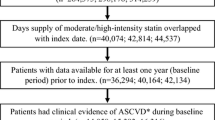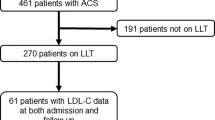Abstract
Purpose
To examine factors associated with HMG-CoA reductase inhibitor (statin) management and the effect of therapeutic modifications on patients’ abilities to reach their low-density lipoprotein-cholesterol (LDL-C) goal in a sample of managed care enrollees.
Methods
This retrospective analysis utilized electronic pharmacy claims, medical claims, and laboratory data, and explored the occurrence and magnitude of modifications to statin regimens. Patients aged ≥18 years who were initiated on statin therapy between 1 January 2001 and 31 December 2001 and who were continuously enrolled for 6 months prior to and 12 months following the index prescription were included. A subgroup analysis incorporated laboratory data to determine whether patients attained their LDL-C treatment goal.
Results
A total of 38 567 patients were identified: 50.6% were female and patients had a mean age of 63.6 ±13.4 years. During a 1-year follow-up, 16.1% (n = 6220) had a modification to their statin regimen. Multivariate analysis showed that significant predictors of regimen modification included age, sex, index statin, index statin potency, and the occurrence of a cardiac reperfusion procedure or acute hospitalization during the 6-month pre-index period (p < 0.05). A subgroup of 254 patients with laboratory data was identified: 57.9% of these patients were female and their mean age was 66.6 ± 10.5 years. Of this cohort, only 14.2% had a modification to their statin regimen. Goal attainment was significantly more frequent among patients whose statin regimen was modified compared with patients whose statin regimen was not modified (72.2% vs 52.8%; p = 0.0294).
Conclusion
The low occurrence of therapeutic modifications and goal attainment may indicate a need for greater awareness of the importance of effective statin use.





Similar content being viewed by others
Notes
The use of trade names is for product identification purposes only and does not imply endorsement.
References
Information adapted from the American Heart Association: heart and stroke statistical update 2003 [online]. Available from URL: http://www.americanheart.org [Accessed 2004 Jul]
Smith CC, Bernstein LI, Davis RB, et al. Screening for statin-related toxicity. Arch Intern Med 2003; 163: 688–92
National Cholesterol Education Program. Third report of the Expert Panel on Detection, Evaluation, and Treatment of High Cholesterol in Adults (Adult Treatment Panel III). Bethesda (MD): National Institute, 2001
Grundy SM, Cleeman JI, Merz NB, et al. Implications of recent clinical trials for the national cholesterol education program adult treatment panel III guidelines. Circulation 2004; 110: 227–39
Marcelino JJ, Feingold KR. Inadequate treatment with HMG-CoA reductase inhibitors by health care providers. Am J Med 1996; 100(6): 605–10
McCabe C. Cost effectiveness of HMG-CoA reductase inhibitors in the management of coronary artery disease: the problem of undertreatment. Am J Cardiovasc Drugs 2003; 3(3): 179–91
Pearson TA, Laurora I, Chu H, et al. The Lipid Treatment Assessment Project (LTAP): a multicenter survey to evaluate the percentages of dyslipidemic patients receiving lipid-lowering therapy and achieving low-density lipoprotein cholesterol goals. Arch Intern Med 2000; 160: 459–67
Foley KA, Simpson RJ, Crouse JR, et al. Effectiveness of statin titration on low-density lipoprotein cholesterol goal attainment in patients at high risk of atherogenic events. Am J Cardiol 2003; 92: 79–81
Sueta CA, Chaowdhury M, Boccuzzi S, et al. An analysis of the degree of undertreatment of hyperlipidemia and congestive heart failure secondary to coronary artery disease. Am J Cardiol 1999; 83: 1303–7
White TJ, Chang E, Leslie S, et al. Patient adherence with HMG reductase inhibitor therapy among users of two types of prescription services. J Manag Care Pharm 2002; 8: 186–91
Iloeje UH, Yu-Isenberg KS, Ventura EP, et al. Treatment of HIV-associated dyslipidemia: a time trend analysis 1998–2001 [abstract]. Antivir Ther 2002; 7: L29–30
White TJ, Chang EY. Incidence of rhabdomyolysis in patients initiated on HMG-CoA reductase inhibitor therapy in a managed care organization [abstract]. Value Health 2001; 4: 98–9
White TJ, Juzba M, Berenbeim DM, et al. Economic outcomes of HMG-CoA reductase inhibitors in a hypertensive diabetic population in a managed care organization [abstract]. Value Health 2000; 3: 138–9
Stockl KM, Vanderplas AM, Chang EY, et al. A model for cardiovascular risk estimation in a managed care population [poster]. American Heart Association, 4th Scientific Forum on Quality of Care and Outcomes Research in CVD and Stroke; 2002 Oct 13–14; Washington, DC
Yu-Isenberg KS, Chang EY, Faich GA, White TJ. Incidence of myopathy after statin drug use: a comparative cohort study [poster]. International Society for Pharmacoepidemiology, 18th International Conference on Pharmacoepidemiology; 2002 Aug 18–21; Edinburgh
Valuck RJ, Williams SA, Saseen JJ, et al. A retrospective cohort study of correlates of response to pharmacological therapy for hyperlipidemia in members of a managed care organization. Clin Ther 2003; 25(11): 2936–57
Von Korff M, Wagner EH, Saunders K. A chronic disease score from automated pharmacy data. J Clin Epidemiol 1992; 45: 197–203
Avorn J, Monette J, Lacour A, et al. Persistence of use of lipid-lowering medications: a cross-national study. JAMA 1998; 279: 1458–62
Schultz JS, SA Williams, JC O’Donnell, et al. Determinants of compliance with statin therapy in a managed care population [poster]. The American Heart Association 2nd Scientific Conference on Compliance in Healthcare and Research; 2004 May 17–19; Washington, DC
Acknowledgments
This research was funded by AstraZeneca LP, Wilmington, Delaware, USA. The research in this manuscript was conducted by researchers from the Pharmacoeconomics and Health Outcomes Research Department of Prescription Solutions®, a pharmacy benefit and medical management company in Costa Mesa, California, USA and the Health Economics and Outcomes Research Department of AstraZeneca LP.
Author information
Authors and Affiliations
Corresponding author
Rights and permissions
About this article
Cite this article
Ory, C., Fontes, C., Williams, S.A. et al. An Evaluation of the Factors Associated with Statin Dose Management and Low-Density Lipoprotein-Cholesterol Goal Attainment. Dis-Manage-Health-Outcomes 14, 37–44 (2006). https://doi.org/10.2165/00115677-200614010-00005
Published:
Issue Date:
DOI: https://doi.org/10.2165/00115677-200614010-00005




